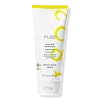What's inside
What's inside
 Key Ingredients
Key Ingredients

 Benefits
Benefits

 Concerns
Concerns

 Ingredients Side-by-side
Ingredients Side-by-side

Water
Skin ConditioningGlycerin
HumectantGlyceryl Stearate
EmollientIsopropyl Palmitate
EmollientCetearyl Alcohol
EmollientCetyl Alcohol
EmollientButyrospermum Parkii Butter
Skin ConditioningCaprae Lac
Skin ConditioningSimmondsia Chinensis Seed Oil
EmollientC13-15 Alkane
SolventCaprylyl Glycol
EmollientCaprylic/Capric Triglyceride
MaskingCarbomer
Emulsion StabilisingCaprylhydroxamic Acid
Panthenol
Skin ConditioningSodium Hydroxide
BufferingSodium Ascorbyl Phosphate
AntioxidantWater, Glycerin, Glyceryl Stearate, Isopropyl Palmitate, Cetearyl Alcohol, Cetyl Alcohol, Butyrospermum Parkii Butter, Caprae Lac, Simmondsia Chinensis Seed Oil, C13-15 Alkane, Caprylyl Glycol, Caprylic/Capric Triglyceride, Carbomer, Caprylhydroxamic Acid, Panthenol, Sodium Hydroxide, Sodium Ascorbyl Phosphate
Water
Skin ConditioningIsopropyl Myristate
EmollientParaffinum Liquidum
EmollientCetearyl Alcohol
EmollientGlycerin
HumectantStearic Acid
CleansingGlyceryl Stearate
EmollientButyrospermum Parkii Butter
Skin ConditioningCeteareth-25
CleansingSimmondsia Chinensis Seed Oil
EmollientDimethicone
EmollientPhenoxyethanol
PreservativeAloe Barbadensis Leaf Extract
EmollientPolysorbate 60
EmulsifyingPolyacrylic Acid
Emulsion StabilisingTriethanolamine
BufferingChlorphenesin
AntimicrobialSaussurea Involucrata Extract
HumectantAvena Sativa Kernel Extract
AbrasiveVitis Vinifera Seed Oil
EmollientRosa Rugosa Flower Oil
MaskingWater, Isopropyl Myristate, Paraffinum Liquidum, Cetearyl Alcohol, Glycerin, Stearic Acid, Glyceryl Stearate, Butyrospermum Parkii Butter, Ceteareth-25, Simmondsia Chinensis Seed Oil, Dimethicone, Phenoxyethanol, Aloe Barbadensis Leaf Extract, Polysorbate 60, Polyacrylic Acid, Triethanolamine, Chlorphenesin, Saussurea Involucrata Extract, Avena Sativa Kernel Extract, Vitis Vinifera Seed Oil, Rosa Rugosa Flower Oil
Ingredients Explained
These ingredients are found in both products.
Ingredients higher up in an ingredient list are typically present in a larger amount.
This ingredient is also known as shea butter. It is an effective skin hydrator and emollient.
Emollients help soothe and soften your skin. It does this by creating a protective film on your skin. This barrier helps trap moisture and keeps your skin hydrated. Emollients may be effective at treating dry or itchy skin.
Shea butter is rich in antioxidants. Antioxidants help fight free-radicals, or molecules that may harm the body. It is also full of fatty acids including stearic acid and linoleic acid. These acids help replenish the skin and keep skin moisturized.
While Shea Butter has an SPF rating of about 3-4, it is not a sunscreen replacement.
Shea butter may not be fungal acne safe. We recommend speaking with a professional if you have any concerns.
Learn more about Butyrospermum Parkii ButterCetearyl alcohol is a mixture of two fatty alcohols: cetyl alcohol and stearyl alcohol. It is mainly used as an emulsifier. Emulsifiers help prevent the separation of oils and products. Due to its composition, it can also be used to thicken a product or help create foam.
Cetearyl alcohol is an emollient. Emollients help soothe and hydrate the skin by trapping moisture.
Studies show Cetearyl alcohol is non-toxic and non-irritating. The FDA allows products labeled "alcohol-free" to have fatty alcohols.
This ingredient is usually derived from plant oils such as palm, vegetable, or coconut oils. There is debate on whether this ingredient will cause acne.
Due to the fatty acid base, this ingredient may not be Malassezia folliculitis safe.
Learn more about Cetearyl AlcoholGlycerin is already naturally found in your skin. It helps moisturize and protect your skin.
A study from 2016 found glycerin to be more effective as a humectant than AHAs and hyaluronic acid.
As a humectant, it helps the skin stay hydrated by pulling moisture to your skin. The low molecular weight of glycerin allows it to pull moisture into the deeper layers of your skin.
Hydrated skin improves your skin barrier; Your skin barrier helps protect against irritants and bacteria.
Glycerin has also been found to have antimicrobial and antiviral properties. Due to these properties, glycerin is often used in wound and burn treatments.
In cosmetics, glycerin is usually derived from plants such as soybean or palm. However, it can also be sourced from animals, such as tallow or animal fat.
This ingredient is organic, colorless, odorless, and non-toxic.
Glycerin is the name for this ingredient in American English. British English uses Glycerol/Glycerine.
Learn more about GlycerinGlyceryl Stearate is a mix of glycerin and stearic acid.
It is used to stabilize the mixing of water and oil ingredients. By preventing these ingredients from separating, it can help elongate shelf life. It can also help thicken the product's texture.
As an emollient, it helps soften skin and supports barrier-replenishing ingredients.
In cosmetics, Glyceryl Stearate is often made from vegetable oils or synthetically produced.
This ingredient may not be fungal-acne safe
Fun fact: The human body also creates Glyceryl Stearate naturally.
Learn more about Glyceryl StearateThis oil comes from the seeds of the desert shrub called Jojoba. It is more commonly known as jojoba oil, a non-comedogenic oil.
Jojoba oil does not contain fragrance and has many fatty-acids, making it a great soothing ingredient.
It also contains Vitamin E, a great moisturizing ingredient. Vitamin E is also an antioxidant and protects your skin against oxidative damage.
This ingredient humectant properties, meaning it helps draw moisture from the air. This helps keep your skin hydrated.
While jojoba has antibacterial properties, it is only able to kill some strains of bacteria.
Studies also show it helps in wound healing. In fact, Indigenous cultures have used jojoba as a moisturizer and to help treat burns for centuries.
Fun fact: Jojoba oil similar to natural human skin sebum, so it has a great effect on dry skin. It is also promising with helping to regulate sebum production.
Due to its fatty acid content, Jojoba oil may not be fungal acne safe. We recommend speaking with a professional if you have any concerns.
Learn more about Simmondsia Chinensis Seed OilWater. It's the most common cosmetic ingredient of all. You'll usually see it at the top of ingredient lists, meaning that it makes up the largest part of the product.
So why is it so popular? Water most often acts as a solvent - this means that it helps dissolve other ingredients into the formulation.
You'll also recognize water as that liquid we all need to stay alive. If you see this, drink a glass of water. Stay hydrated!
Learn more about Water